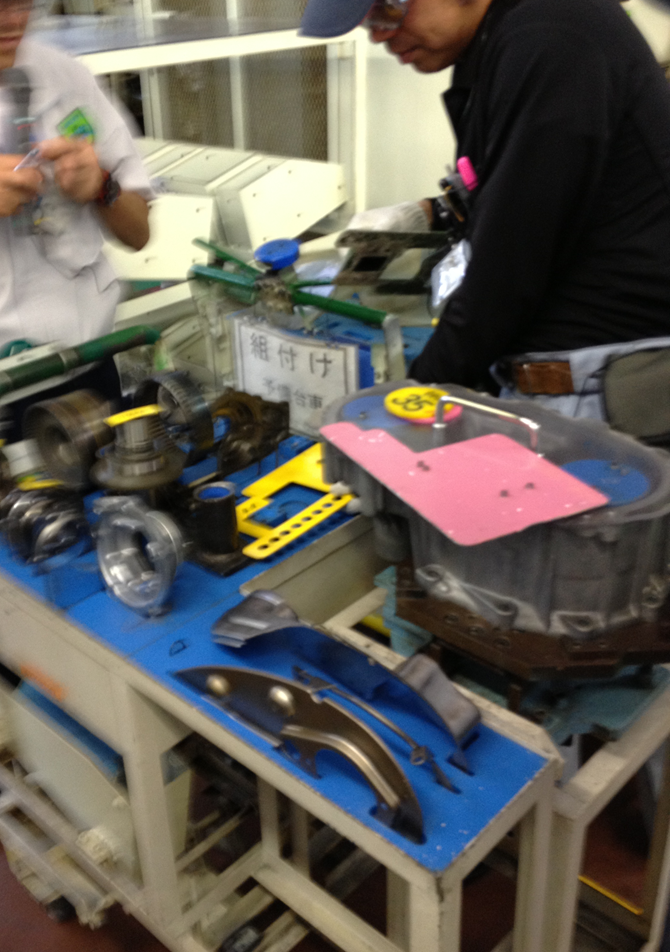Applying the Toyota Production System (TPS) to Automated Manufacturing Processes: Honsha Example
On July 8, I had the privilege of visiting Toyota’s Honsha plant and meeting Ohno Disciple Mitsuru Kawai, the company’s Senior Technical Executive. This is a title that is restricted to the best of the best in the Toyota Production System (TPS).

On July 8, I had the privilege of visiting Toyota’s Honsha plant and meeting Ohno Disciple Mitsuru Kawai, the company’s Senior Technical Executive. This is a title that is restricted to the best of the best in the Toyota Production System (TPS). As an Ohno student, Kawai developed a passion for continuous improvement as well as the obligation to teach. He attended the Toyota Technical High School and worked his way up all the way from a production team member. Since graduating, he has spent 50 years at Toyota, and 40 of those years in forging.
The Honsha plant makes forged metal products used in engines. The basics of TPS were already in place when Kawai joined, but his job involved more than managing a well-functioning plant. His target was to improve production labor efficiency 102 percent over the previous month, every month. This goal continued for his entire career, even through all the crises of the last four years faced by Toyota.
One obvious approach to this relentless improvement was automation. But, this provided a special challenge for Kawai. He had learned the skills of TPS through manual work, visualization, making knowledge explicit, standardized work, and simple intelligent automation (jidoka). The younger people working in the plant, however, only knew automation.
In an effort to teach TPS in this automated plant, Kawai devised a number of lessons. One in particular that is still held each week coined “my machine meetings” requires students to hand-draw the process inside the automated machines using paper and pencil. He believes sketching the process by hand at the gemba leads to a better understanding and memory of the process.
As the students sketch, they look for problems, and specifically, defects. When they started the drawings, there were 2,004 defects per year. But, after only one year of carrying out this practice, this number was reduced to almost zero.
Another approach Kawai enforced actually stopped automation. He, instead, had highly skilled workers do the processes manually. By doing this, it provided new ideas for kaizen when the machine was rebuilt. As a result, they were able to reduce the complexity of lines in half.
The recession also shed some new light on the automation process. Kawai and his team realized that it was not only inflexible, since it merely made a specialized set of parts, but that also, its fixed costs were high. In an effort to respond to this predicament, their approach became: “Make it small, and make it grow.” The focus was to create a multi-product line, simplify the automation, make the lines shorter, and make manual labor flexible in order to adjust easily to demand.
In addition to these actions, Honsha used a novel approach to teach TPS basics. When the “basic TPS line” was set up in Brazil some 75 years earlier, these simple cells did forging and assembly using a lot of manual work and simple intelligent automation. It was then continuously improved with the teaching of Ohno who believed they should be able to make a profit with small volumes. Through his methodologies, the people working in a cell went from 10 to 1 through repeated kaizen on the slow line with a 6-minute cycle.
The team in the Honsha plant started immediately to do kaizen and was able to shrink this lean line further by 50 percent. They used a heijunka (leveling box) to schedule the day for different customers, which leveled production by volume and mix each day.
Another issue that arose involved errors in selecting the right parts for a particular product. With modern technology, lights would come on to tell the operator which parts to pick. When a wrong part was selected, it would trigger an alert. The team needed a simple way to do this manually. Fortunately, someone came up with a “key kanban.”
 Figure 1: Key Kanban for #8 parts’ bin inserted
Figure 1: Key Kanban for #8 parts’ bin inserted
 Figure 2: #8 parts’ bin door opens
Figure 2: #8 parts’ bin door opens
The kanban is unique in that it comes back and signals the need for a part. It is metal with a specific configuration, and, when inserted, it will open only the door for the particular part that needs to be selected.
Another simple kaizen for mistake-proofing that was developed assembles kits of parts for a single product on a wheeled cart. This is necessary since there is a large variety of parts both that are needed and unneeded for particular versions of the product. For an assembly that does not need all the parts, the sized cut-out spaces that the parts fit into are covered with a colored template so that no part can be mistakenly put into them.
 Figure 3: Mistake-proofed parts’ kit closes off unused parts
Figure 3: Mistake-proofed parts’ kit closes off unused parts
The purpose of bringing this simple and very old line from Brazil was to pass on the basics of real TPS to the next generation. Mitsuru Kawai has a simple viewpoint: “The material should be flowing through the machines while changing the shapes at a speed that will see in the market (takt). Everything else is waste.”
Dr. Jeffrey Liker is professor of industrial and operations engineering at the University of Michigan and author of The Toyota Way. He leads Liker Lean Advisors, LLC and his latest book (with Gary Convis) is The Toyota Way to Lean Leadership.
- Category:
- Industry
- Manufacturing
Some opinions expressed in this article may be those of a contributing author and not necessarily Gray.